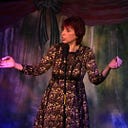The Story Of Your Life Is Not What Happened, It’s What Changed
“Its either a great time or a great story.” Spalding Gray
There are three core kinds of calls for change in life:
1) Desire — we want to expand, learn or actualize something better;
2) Adversity —we take up a fight or challenge oppression;
3) Back against the wall — life throws us into the unknown world;
In Jessica Piscitelli Robinson’s recently published memoir Stages: My Life In Stories, there are takes on all three. A chapter titled “High School Mosh Pit” describes the desire to both belong and be herself amid the social mine fields of high school. “The Talk” deals with her sexual trauma and how it shaped her commitment to showing up for her children with whatever truth they have to share. And “I Said I Love You” details what it is like to face the future and the world without her mother in it, just three months after her wedding day.
Each chapter in this memoir explores a period or experience that marks some dimension of her development, from childhood to motherhood, from NYU film student to the professional storyteller, author, keynote speaker, and teacher she is today. And stories are central to her life’s work. She founded a non-profit storytelling organization called Better Said Than Done (tag line “life is better in the telling”) that produces a range of events: live shows in-person and online, classes, workshops and community partnerships.
Because of the call at the start — and the heart — of each experience explored, the book demonstrates the power of looking at life through a storytelling lens. “In the storytelling workshops I teach, I emphasize that a story should be about something and/or have a point,” says Robinson in an interview for this article. “I have had many traumatic incidents and periods of time in my life. If it’s just that I had this bad thing happen, that’s not a great story. But when I turn those moments into a story, I ask myself, what am I trying to say?”
An event is something that happens. The story of the event is what happens inside of us and how we act on it. When following the desire for something new or to accomplish a goal, do we retreat or push on when it gets tough? (See “Life’s A Marathon” in Robinson’s book). There is no right or wrong answer to that question, because a call for change can take us down dark paths as much as to triumph and transformation. When stubborn oppressive norms create unnecessary daily stress, how does that shape our inner life? (See “There’s Always One”).
Like the arc of a great, true hero’s journey, stories start with the call, but the struggle is what draws us in. Each story in this memoir could stand alone, but each beginning, middle, and end leads on to another step, another story. Life experiences that shaped Robinson’s current self are distilled into fascinating, frank, accounts of difficult passages that have sudden, surprising moments of humor.
Her capacity to inject the funny in what are otherwise serious stories is hard-won and field-tested in difficult first-hand experience. “My family was my training ground, Robinson shares. “I learned that humor had a place in trauma — but not in every moment and not every joke. An example: When I had just turned twelve, my mom got breast cancer and had to have a mastectomy. We were all crying when she told us the news. To lighten the mood, I made a joke about Terms of Endearment. That bombed. We cried even more. As we talked, we learned that the doctors had apparently told my mom they might try to save her nipple for reconstructive surgery. We started talking about where they should save it –palm of her hand, middle of her forehead, etc. Those jokes landed. The lesson: too soon, too much, not good.”
Trauma, grief and loss — the “back against the wall” calls for change — and living with the aftermath, is what happens. Who we become, what transforms within us as we work through it — the story of what happened — can include moments of transcendence, wonder, and humor. “As I started telling stories on stage,” says Robinson, “I also learned that not everyone in the audience appreciated my humor in otherwise serious stories, because
not everyone thinks there is a place for humor in trauma. And that’s okay.”
Examining our experiences through the storytelling lens is a way to give them meaning, to galvanize our creative self and be the main character in our own hero’s journey. Our lives are like a book that is still being written, so every ending is really just a marker of what changed as a new chapter unfold. As vividly, powerfully expressed in Stages: My Life In Stories, we can look at our life as a dynamic creation. The story is the meaning we make and it is better in the telling.
Jude Treder-Wolff is a creative arts therapist, social worker, improviser, storyteller and writer/performer. She hosts and curates (mostly) TRUE THINGS, a game wrapped in a storytelling show performed in Port Jefferson, NY.
